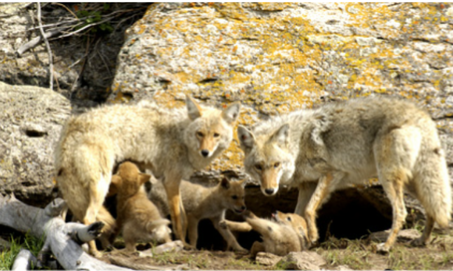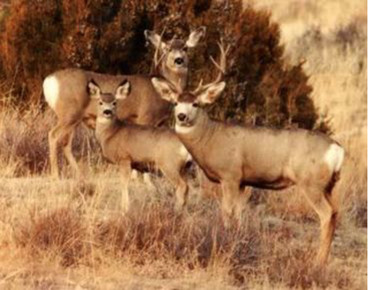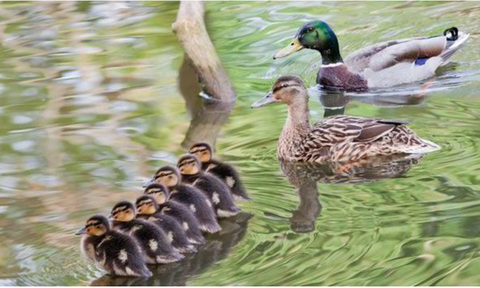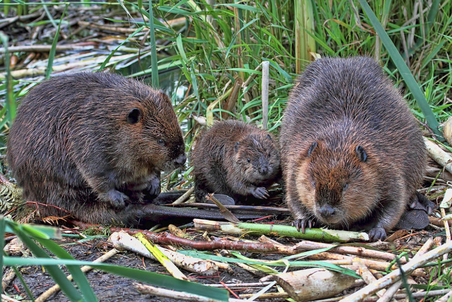It makes sense to start with one of our favorite animals, the beaver! These aquatic mammals can be three to four feet in length and can weigh up to 40 pounds! Beavers use their long orange-colored teeth to chomp down trees to drag into the water to build dams and lodge. Beavers are some of the most romantic animals around- they mate for life. And given that beavers can live for up to 24 years in the wild, beaver relationships can last for up to two decades! Beaver moms will have a litters of two or three babies, or kits. These youngster will stay will their families in the same dam and lodge structure until they mature, at about 2 years old.

These intelligent members of the canine family vary in size between three to four feet, and between twenty and fifty pounds, based on gender. Their long bushy tails make them very distinct. Coyotes spend much of their time alone, but when they are ready to mate, they will stay with their partner for several years at a time. Often times, unrelated pairs will form groups called packs to help raise the young. Mating pairs will take over abandoned dens, to raise their babies. Litters of babies can have between five and seven cubs, who are all born sightless and hairless. Cubs will open their eyes after ten days, but stay in the protection of the den for eight or ten weeks. Once they emerge, they will begin play-fighting to help develop skills that will benefit the pack or be helpful for a solo life.

Mule deer will grow to about three feet at the shoulder, and can weigh between 100 to 300 pounds depending on gender. The male deer, or bucks, will have forked antlers, which definitely increases their weight. Female deer, or does, stay in multi-generation families of females and offspring. Bucks will stay with this groups, until they reach about one year old.
Bucks who find a doe that is interested in them, will stay close to her during the late-fall mating season, or rut. Bucks will try to intimidate other interested bucks—the one who is the heaviest or has the largest set of antlers—will often be the most successful. Bucks will mate with as many does as possible, sometimes to the point of exhaustion that does not allow them to survive the winter months. Does will give birth in the early summer to one or possibly two fawns. After a few weeks they will start to follow the mother to find food. This new family will join up with their multi-generational family once the fawns are strong enough.

These distinct waterfowl are easy to spot along The South Platte River. The male ducks, or drakes, have a green head with a white neckband and a brown and gray body. The females, are several shades of brown to help them camouflage when nesting. Mallard ducks can grow to 26 inches and can weigh up to three pounds.
Unlike other animals, the female ducks are the first ones to show interest in a mate, by swimming and preening near a potential mate. Mating pairs will build nests on the ground, and can get very territorial during this time. Once the female has laid anywhere from three to twelve eggs, and incubation of the eggs have started, the male ducks will leave to join up with other drakes. Some drakes show a little more romance by protecting the female and eggs until they hatch.

Foxes in this region have a distinct red coat, large ears, and a busy tail. Male foxes, or dogs, are solitary animals for most of the year. When the winter mating season comes, the dogs will look for females, or vixen, to spend the winter with. Dogs show their romantic side when it comes time to raise the babies, or kits. The mother will stay in th
e den with the kits (who are born deaf and sightless) for the first four to five weeks, while the father will be the sole provider of food for the whole family.
Foxes are maybe the most the humans—they don’t all follow a certain pattern. Pairs can mate for life, a few seasons, or just one season. Both dogs and vixens may have multiple partners, but will typically chose just one to raise kits with. If one dog has multiple vixen mates, the vixens may all live in the same den and raise their young together. Vixens typically give birth to around five kits, but some litters can be as big as twelve!

It only makes sense to finish this post with our second favorite animal- the crawdad! Both the male and female look similar, but the male crawdad has an extra set of legs on its torso, and the female has a receptacle for mating. Crawdads have hard exoskeletons that they must shed in order to grow larger. A crawdad will need to molt between five and eleven times (or be five to eight years old!) before it is mature enough to mate.
Crawdads will mate in spring in the open water. It’s the females turn to be slightly less romantic by mating with several male partners. After mating, the female crawdad will create a burrow, typically near the water’s edge. The eggs will stay attached to the mother from anywhere from two to twenty weeks depending on conditions.



Hey will if you see this I just found some Beaver emojis🐈🐱
and also so cute